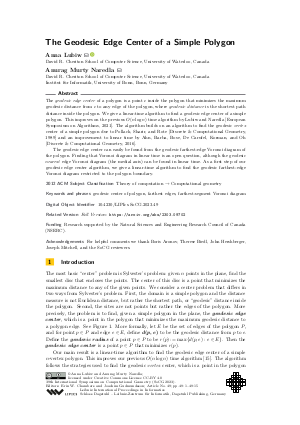@InProceedings{lubiw_et_al:LIPIcs.SoCG.2023.49,
author = {Lubiw, Anna and Naredla, Anurag Murty},
title = {{The Geodesic Edge Center of a Simple Polygon}},
booktitle = {39th International Symposium on Computational Geometry (SoCG 2023)},
pages = {49:1--49:15},
series = {Leibniz International Proceedings in Informatics (LIPIcs)},
ISBN = {978-3-95977-273-0},
ISSN = {1868-8969},
year = {2023},
volume = {258},
editor = {Chambers, Erin W. and Gudmundsson, Joachim},
publisher = {Schloss Dagstuhl -- Leibniz-Zentrum f{\"u}r Informatik},
address = {Dagstuhl, Germany},
URL = {https://drops.dagstuhl.de/entities/document/10.4230/LIPIcs.SoCG.2023.49},
URN = {urn:nbn:de:0030-drops-178994},
doi = {10.4230/LIPIcs.SoCG.2023.49},
annote = {Keywords: geodesic center of polygon, farthest edges, farthest-segment Voronoi diagram}
}

 Creative Commons Attribution 4.0 International license
Creative Commons Attribution 4.0 International license
